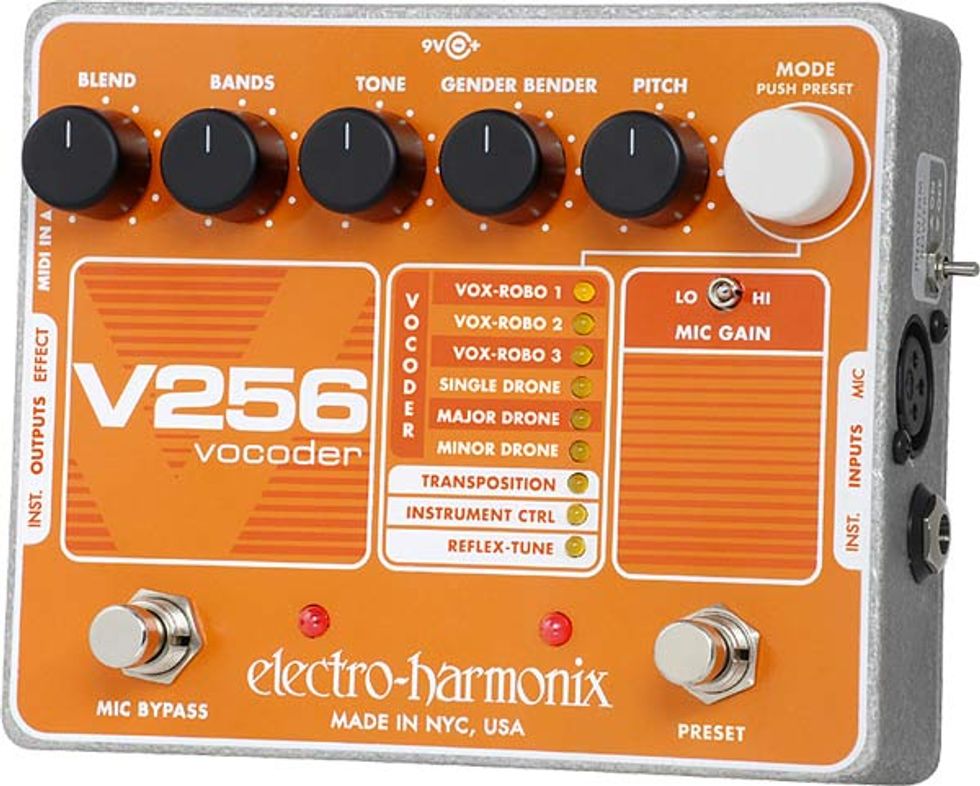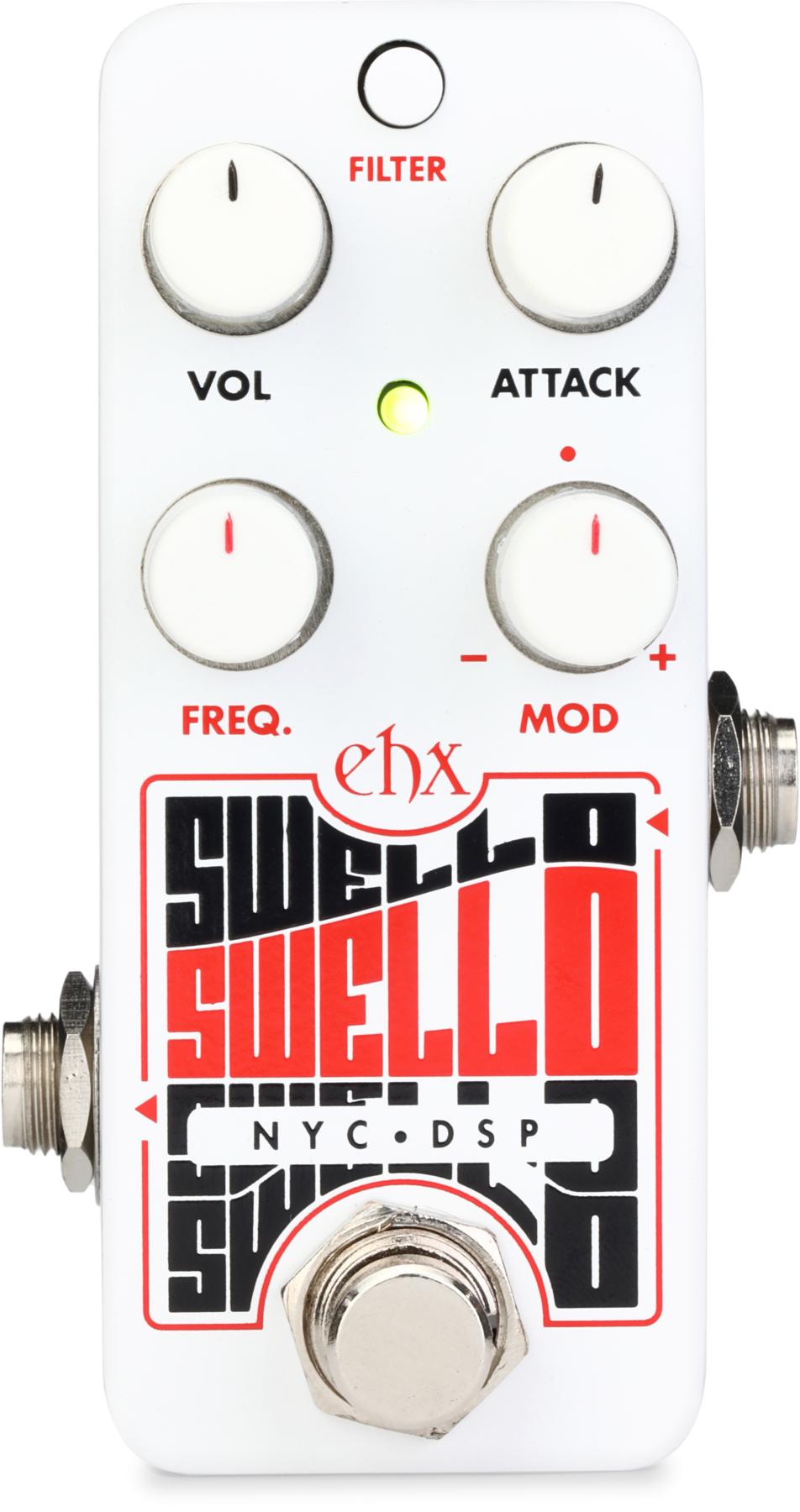| Download Example 1 Instrument control (guitar work changes vocal pitch) with Blend full, all other controls at noon. | |
| Clip recorded with a '78 Les Paul Custom through a Mesa Boogie Electra-Dyne half stack. | |
Since then, the vocoder has cemented its place in several genres of music, effectively making it more of an instrument in itself than an effect in some cases. So many genres have felt its presence, from the voice of Mr. Roboto in Styx’s classic, to the voices of the famous robots in Transformers. Now, hot on the heels of their well-received Voice Box, Electro Harmonix has released the V256 Vocoder for musicians in a compact form. The V256 shares some things in common with the aforementioned Voice Box, but shines on its own as a dedicated tribute to the vocoder sound.
Modes and Controls
The layout of the V256 is quite simple. Starting from the left, there is a Blend control, which blends the affected signal with the dry. Next is a control labeled Bands, which tells the V256 how many bands should consist in the filter. Each band is processed by an envelope follower, which is what gives the vocoder its unique sound; with several signals processed by a separate envelope follower are combined, the result is the distinctive vocoder tone. Vintage vocoders, such as the ones produced by Bob Moog, used 10 bands or less. As a result, the vocal sounds created by those devices were rather rough and glitchy compared to the vocoder tones of today. The V256 has a range of a miniscule 8 bands all the way up to a smooth-sounding 256 bands. A Tone control helps roll off the highs, and finally, the Gender Bender gives the vocalist the ability to give their voice the traits of the opposite sex, or more of the actual one, and can be altered by a Pitch knob.
A total of nine modes are accessed from the Mode rotary control, which consist of three robotic synths, three drone synths (single, major or minor), and three transposition modes consisting of Instrument Ctrl, Transposition, and Reflex-Tune (for you T-Pain fans out there).
Plug, Tweak, Repeat
One of the best things about my job is that no matter how much gear that I come across, there’s always something coming down the pipe that I can learn more from. The V256 is a perfect example, as the only reference that popped up in my mind was Peter Frampton and his talkbox. I decided to dive right into exploring the V256, starting with a squeaky-clean setting from a Mesa Boogie Electra-Dyne half-stack and a 1978 set-neck Ibanez Iceman. The V256 has dual inputs and outputs, one on each side for a microphone XLR connection and a standard ¼” TRS instrument plug. I had the option of using both a P.A. (from the XLR out) and the guitar amplifier (from the ¼” out) in tandem, but I decided to see how well the pedal performed with both signals combined, going straight into the Electra-Dyne. I figured that this would be the most common setup for the gigging guitarist, one with minimal effort and connections.
Starting with the basic vocoder settings recommended in the paperwork (full Blend and Pitch, Bands, Tone, Gender Bender at noon), I struck a single note and sang in the mic, which started to wobble and sway robotically as I played around the fretboard. I must say, it is a very strange feeling, especially for someone who has spent most of his guitar playing days stomping on a pedal and not looking back. Pulling back the Pitch control engaged the internal synthesizer, which really kicked my voice into eighties cartoon robotic gear.
Around this time, I started to experience some feedback issues. The V256 has a Mic Gain switch, but at the time it was switched to the Low setting. When I finally switched from an SM58 to an SM57, the feedback vanished, signaling that the V256’s mic input is rather sensitive (which is a good thing). At this point, I was so excited at the prospect that I had a entirely new effect that I had never played around with before, that I just started going crazy with the controls. Combining the output with a light distortion yielded some really cool industrial vocal lines, a la Skinny Puppy, Ministry and Nine Inch Nails. The Instrument Transposition mode (Instrument Ctrl) was especially fun, effectively allowing me to change what notes my voice would jump to by simply playing them on my guitar. The possibilities are endless for those who really enjoy the more modern side of pop and rock vocals. The Reflex-Tune mode is a prime example—it’s Electro-Harmonix’s interpretation of the now-infamous Autotune warble.
The Final Mojo
Electro-Harmonix is known for a lot of things, and portability and usefulness are definitely some of them. Their eccentric nature throughout the years has produced some of the most coveted sounds of all time. While only time will tell if the V256 Vocoder will join the ranks of their most famous pedals, it is safe to say that it certainly has the capabilities and uniqueness to do so. They’ve effectively taken what was considered to be a one-trick pony and squeezed out all of the prospects that it could be capable of, and crammed them into this diminutive device. However, like so many other effects, it has a time and a place, and it definitely won’t get stepped on as often as a good overdrive or delay. For those who want to push their boundaries just a little further however, the V256 might be just the ticket.
Buy if...
You want to see just how far vocal processing can take your guitar tones, and vice versa.
Skip if...
Strange and otherworldly effects are not in your nature.
Rating...
MSRP $286 Street $215 - Electro-Harmonix - ehx.com |






![Rig Rundown: Russian Circles’ Mike Sullivan [2025]](https://www.premierguitar.com/media-library/youtube.jpg?id=62303631&width=1245&height=700&quality=70&coordinates=0%2C0%2C0%2C0)


















